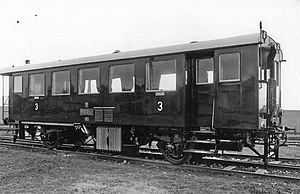ČSD series M 122.0
| ČSD series M 122.0 | |
|---|---|
|
Factory photo M 122.0
|
|
| Numbering: | M 122.001-028 |
| Number: | 28 |
| Manufacturer: | Vagonka Studénka Studénka |
| Year of construction (s): | 1930-1932 |
| Retirement: | -1953 |
| Axis formula : | A1 |
| Gauge : | 1435 mm ( standard gauge ) |
| Length over buffers: | 11,800 mm |
| Length: | 10,800 mm |
| Height: | 3,500 mm |
| Width: | 3,100 mm |
| Total wheelbase: | 5,800 mm |
| Empty mass: | 18.8 t |
| Service mass: | 22.6 t |
| Friction mass: | 11.6 t |
| Wheel set mass : | 12 t |
| Top speed: | 50 km / h |
| Installed capacity: | 100 hp |
| Driving wheel diameter: | 1,000 mm |
| Wheel diameter: | 1,000 mm |
| Motor type: | TATRA petrol engine |
| Motor type: | 6-cylinder in-line |
| Rated speed: | 1,200 rpm |
| Power transmission: | electric |
| Tank capacity: | 200 l |
| Train brake: | KNORR |
| Seats: | 48 |
| Classes : | 3. |
Two- axle railcars of the former Czechoslovak State Railways (ČSD) for traffic on main and branch lines were designated as ČSD class M 122.0 .
history
In 1930 this motor vehicle was built by ČSD with electrical power transmission using the simple GEBUS system . The company with its factories in Vienna and Salzburg dealt with the electrical equipment of electric rail vehicles.
The vehicles of this power transmission were popular because of their simplicity and formed the basis for the perfection of the transmission with DC traction motors.
technical features
The basis of the power transmission of the vehicle is a 6-cylinder, 4-stroke petrol engine from TATRA , which is firmly connected to the armature of the generator. The various power levels of the generator were controlled by resistors. The generated electricity was fed via a rectifier to the serial traction motor of the car. The power control of the vehicle was controlled by the resistors, between these and the controller of the combustion engine there was a mechanical connection. The performance of the combustion engine was continuously increased.
The vehicle body consisted of 3 compartments. The passenger compartment had 48 seats, at the tips of the box were the entry area and the specially partitioned driver's cab of the railcar. At the top there were crossings from car to car with secured bridges. Characteristic of the car body were the recessed doors and the door behind the driver's cab that was moved towards the middle. The radiator of the internal combustion engine was arranged laterally in the middle of the vehicle and gave it its characteristic appearance. It was heated by the exhaust gases from the internal combustion engine.
commitment
The wagons quickly established themselves on the numerous local ČSD railways and were a popular means of transport in the period up to the Second World War . There is evidence that a vehicle was in use on the Roudnice nad Labem – Zlonice railway from 1931 to 1948.
With the commissioning of the new class M 131.1 railcars , these gradually became superfluous and were retired in the 1950s. The last copy in this series was retired in 1953. No vehicle from the M 122.0 series has been preserved in a museum.
The railcars of the M 122.0 series formed part of the diverse selection of railcars at the former ČSD . The number of these cars built was relatively small. The practice with them brought the realization that the diesel engine was a better alternative to the internal combustion engine and, in the case of smaller vehicles, diesel-electric vehicles are more expensive than vehicles with diesel-mechanical power transmission. In operation, they showed some advantages over them, especially when it came to traffic on steep slopes.
See also
literature
- Jindřich Bek Malý atlas lokomotiv magazine Železničář (Czech).
- Ing.Vlad. Londin Motory Vuz rady M 122.0 Železničář magazine (Czech).

